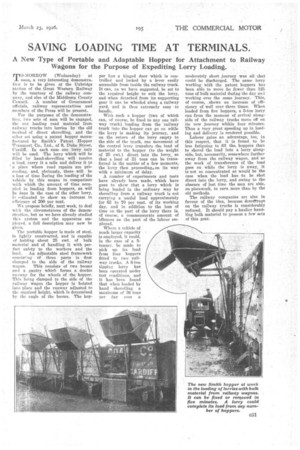SAVING LOADING TIME AT TERMINALS.
Page 19

If you've noticed an error in this article please click here to report it so we can fix it.
A New Type of Portable and Adaptable Hopper for Attachment to Railway Wagons for the Purpose of Expediting Lorry Loading.
MO-MORROW (Wednesday) at
noon, a very interesting demonstration is to be given at the Uxbridge Station of the great Western .RaiIway by the courtesy of the railway company, and also of the Middlesex County Council„ A number of Government officials, railway representatives and members of the Press will be present: For the purposes of the demonstration, two sets of men will be engaged, the one loading road material from railway trucks into lorries by the old method of direct shovelling, and the other set usin.g a patent hopper manufactured by Smith's Patent Hopper Transport Co., Ltd., of 9, Duke Street, Cardiff. In each case one lorry only will be used. The lorry which will be filled by hand-shovelling will, receive a load, carry it a mile and deliver it to a place where road repairs are proceeding, and, obviously, there will be a loss of time uring the loading of the vehicle by this means in comparison with which the amount of time occupied in loading from hoppers, aswill be done in the case of the other loPrY, is estimated to show an increase in efficiency of 200 per cent.
We propose briefly, next week, to deal with the circumstances of the demonstration, but as we have already studied this system and the apparatus employed, a full description may now be given.
The portable hopper is made of steel,. is lightly constructed, and is capable of holding about 25 cwt. of bulk material and of handling it with perfect safety to the workers and the load. An adjustable steel framework consisting, three parts is first clamped to the side of the railway wagon. This consists of two booms and a gantry which forms a double runway for the wheels of the hopper. This being clamped to the side of the railway wagon the hoptier is hoisted into place and the runway adjusted to the required height, which is determined by the angle of the booms. The hap per has a hinged door which is controlled and locked by a lever easily accessible from inside the railway truck. it can, as we have suggested, be set to the required height to suit the lorry, and when detached from its supporting gear it can be wheeled along a railway yard, and is thus extremely easy to handle.
With such a hopper (two of which can, of con ice, be fixed to any one railway truck) loading from the railway truck into the hopper can go on while the lorry is making its journey, and on the return of the lorry empty to the side of the truck, One movement of the control lever transfers the load of material to the hopper (to the weight of 25 cwt.) direct into the lorry,. so that a load of 2k tons can be transferred in the matter of a few moments, the lorry then proceeding., on its way with a minimum of delay.
A number of experiments and tests have already been made, which have gone to show that a lorry which is being loaded in the ordinary way by shovelling from a railway truck is not carrying a useful load approximately for 65 to 70 per cent, of its working day, and in addition to the loss of time on the part of the lorry there is, of course, a commensurate amount of idleness on the part of the labour employed.
Where a vehicle of much larger capacity is employed, it could, in the case of a 5tonner, he made to pick up its load from four hoppers fitted to two railway trucks. A 6-ton tipping lorry has been operated under test conditions, and it has been' found that when loaded by hand shovelling a maximum of 36 tons per day over a moderately short journey was all, that could be discharged. The same lorry working with the patent hoppers has been able to move no fewer than 125 tons of bulk material during the day and -working over the same journey. This, af course, shows an increase of efficiency of well over three times. When loaded from five hoppers, a 5-ton lorry can from the moment of arrival alongside of the railway trucks move off on its new journey within four minutes. Thus a very great speeding up in loading and delivery is rendered possible.
Labour gains an advantage, too, in
this respect, that it is foundbe less fatiguing to fill the, hoppes than to shovel the load into a lorry alongside, but, necessarily, somewhere further away from the railway wagon, and as the work of transference of the load goes on while the lorry is away, it iS not so concentrated as would be the case when the load has to be shot direct into the lorry, and owing to the absence of lost time the men are able, on piecework, to earn more than by the old methods.
The railway companies are also in favour of the idea, because demtfrrage on the railway trucks is considerably reduced. It should pay a haulier handling bulk material to possess a few sets of this gear.
































